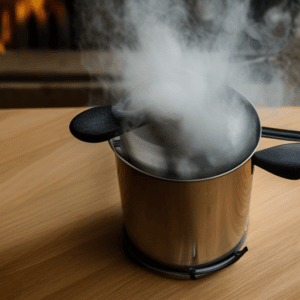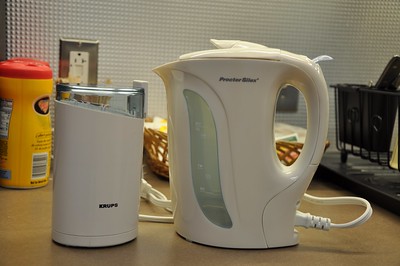Have you ever found yourself asking the question, “how does a kettle work?” We take a lot of the appliances we use every day for granted – including modern electric kettles. However, it’s easy to start wondering when you’re admiring how efficient your electric tea kettle is in comparison to the typical stovetop kettles earlier generations used to have.
A kettle is a straightforward but useful appliance that is typically found in households around the world. Yet the majority of people couldn’t tell you how your kettle boils.
Today, we’re going to take a closer look at how an electric kettle works, how its functionality compares to old-fashioned whistling kettles and more.
How Do Kettles Work? The Types of Kettles
One point worth noting is the “type” of the kettle has a huge impact on how exactly the appliance works. For instance, if you’re wondering, “how does a cordless kettle work?” the answer is likely to be different to figuring out how old-fashioned tea kettles can create boiling water.
Fundamentally, a kettle is simply a container in which you use a heating element or component capable of producing heat or raising the temperature of the water in the container to boiling point. An electric kettle works by using a heating element within the kettle container itself. Alternatively, a stovetop tea kettle would use a gas flame or another heat source, like an open fire.
The device will convert energy into heat, so your water boils no matter what kind of kettle you choose. Some specialist equipment can even help you control the specific temperature of your water so you get the right temperature every time.
How Do Kettles Heat Water?

Tea kettles heat water generally by absorbing the heat of the fire or other heat source they’re exposed to. If you place a tea kettle on top of a gas stove, its flat bottom, making direct contact with the heat, will gradually begin to boil the water inside.
Stove kettles are made specifically from materials that can withstand frequent exposure to high heat to help with boiling water. When the water in the stove kettles reaches a certain temperature, the water inside begins to convert into steam. A steam tube within the kettle carries steam to an outlet in the kettle, which creates a whistling sound, letting you know the water is boiled.
An electric kettle takes this somewhat simplistic system of heating water to the next level. With an electric kettle, two important parts work together. The first component is the heating element, a resistor designed to resist the flow of electricity, which turns into heat energy. The heating element converts the electricity running through your kettle into heat to boiling water quickly.
The second component of an electric kettle is the thermostat. This is the technology incorporated into your kettle to let you know when the water reaches a certain temperature. The thermostat is connected to the heating element in an electric kettle in such a way that it actually controls the heating element. When the water starts to boil, the thermostat switches the heating element off.
How Does a Kettle Know When It’s Boiled?
It’s often easier to understand how a traditional kettle could brew tea and coffee than it is to figure out how electricity could power your kettle. When using an old-fashioned kettle, it’s easy to see how the heat or fire heats the kettle and makes the water inside hot. You will not always see what’s going on when you flip the switch on your device with a kettle.
An electric kettle knows when the cold water inside boils because it’s connected to a thermostat. The thermostat in your kettle connects with the water in the kettle and has a variable resistor inside it. Once the user sets the required temperature and flips the switch to enable an electric current, the thermostat controls the heating environment accordingly.
Unlike a traditional kettle, an electric kettle with a thermostat can detect the exact temperature reached. When your water boils, the thermostat detects it’s time to stop the electricity flowing, and your switch automatically moves from “on” to “off mode”.
The thermostat function in a modern tea kettle is how some devices allow users to choose the exact temperature they boil water in an electric tea kettle. For instance, you could set your kettle to turn off when the water is just below boiling, so you can drink coffee and tea immediately rather than waiting for it to cool down.
How Do Electric Kettles Boil Water So Fast?
Electric kettles work much more efficiently than the old stovetop kettle. This is because of the way electric kettles use a heating element to convert electrical energy into heat to get your water to its boiling point. To heat water as quickly as possible, you need to minimise the amount of energy lost during the heating process.
If you’ve ever tried to boil water with a whistling kettle, you’ll know these old tea kettles can take much longer to get the water to boiling points. It is because the heat energy is constantly being absorbed into the environment around the kettle rather than into the kettle itself.
On the other hand, with an electric kettle, the heating element inside the device or the “metal coil” used for heating the water is in direct contact with the water. The technology can save energy because today’s tea kettles directly connect the heating coil and the water. The coil has electrical resistance built in to prevent electrocution. The connection to a thermostat also means you can top electricity flowing into the water at any point.
The original electric kettles didn’t put the heating element in direct contact with the water. However, today’s tea kettles have evolved to use this strategy to get the water to the boiling point for your tea and coffee much more quickly. You can boil all the water in your kettle much quicker with electric power.
What Happens to a Kettle of Boiling Water?

So, how does a kettle work? The simplest answer to this question is that the energy in your kettle, which comes from electric power or fire, converts into heat energy to make your coffee or tea. For an electric kettle, the core component is the heating element, a thick coil designed to handle high currents of electricity. When this cooking coil is filled with electrical energy, it heats up. The heated element then causes the water in your kettle to boil.
Depending on the type of kettle you have, you might be able to choose how hot your water gets. The usual answer to “what temperature does a kettle boil to?” is around 100 degrees Celsius, but it is possible to adjust this with some thermostat technology.
Once your kettle reaches the right temperature for the coffee drinkers or tea drinkers in your house, the element that heats the water switches off automatically, you can then remove the lid of the kettle and pour a cup of coffee just how you like it.
Now that you know which elements make an electric kettle work, how a thermostat can stop electricity flowing, and why electric kettles are so efficient, you’ll have plenty of chat about over your next cup of coffee.

